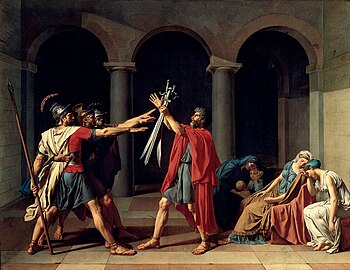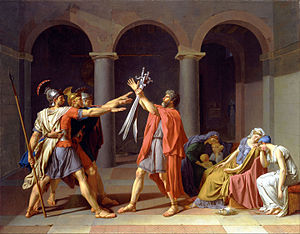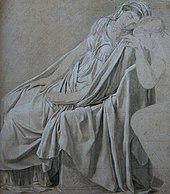
Jacques-Louis David was a French painter in the Neoclassical style, considered to be the preeminent painter of the era. In the 1780s, his cerebral brand of history painting marked a change in taste away from Rococo frivolity toward classical austerity, severity, and heightened feeling, which harmonized with the moral climate of the final years of the Ancien Régime.

Lucius Junius Brutus was the semi-legendary founder of the Roman Republic, and traditionally one of its first consuls in 509 BC. He was reputedly responsible for the expulsion of his uncle the Roman king Tarquinius Superbus after the suicide of Lucretia, which led to the overthrow of the Roman monarchy. He was involved in the abdication of fellow consul Tarquinius Collatinus, and executed two of his sons for plotting the restoration of the Tarquins.

Tullus Hostilius was the legendary third king of Rome. He succeeded Numa Pompilius and was succeeded by Ancus Marcius. Unlike his predecessor, Tullus was known as a warlike king who according to the Roman Historian Livy, believed the more peaceful nature of his predecessor had weakened Rome. It has been attested that he sought out war and was even more warlike than the first king of Rome, Romulus. Accounts of the death of Tullus Hostilius vary. In the mythological version of events Livy describes, he had angered Jupiter who then killed him with a bolt of lightning. Non mythological sources on the other hand describe that he died of plague after a rule of 32 years.

In the ancient Roman legend of the kingdom era, the Horatii were triplet warriors who lived during the reign of Tullus Hostilius. The accounts of their epic clash with the Curiatii and the murder of their sister by Publius, the sole survivor of the battle, appear in the writings of Livy.
Sororicide is the act of killing one's own sister.

The Tragedy of Lucretia is a tempera and oil painting on a wood cassone or spalliera panel by the Italian Renaissance master Sandro Botticelli, painted between 1496 and 1504. Known less formally as the Botticelli Lucretia, it is housed in the Isabella Stewart Gardner Museum of Boston, Massachusetts, having been owned by Isabella Stewart Gardner in her lifetime.

Mettius Fufetius was a dictator of Alba Longa, an ancient town in central Italy near Rome. He was appointed to his position after the death of Alban king Gaius Cluilius. When a full-blown war threatened to erupt between the Albans and the Romans, Fufetius proposed to the third legendary King of Rome, Tullus Hostilius, that a smaller 3 vs. 3 battle should decide the fate of their cities. Having lost this duel, the Albans submitted themselves to Roman rule.

The kings of Alba Longa, or Alban kings, were a series of legendary kings of Latium, who ruled from the ancient city of Alba Longa. In the mythic tradition of ancient Rome, they fill the 400-year gap between the settlement of Aeneas in Italy and the founding of the city of Rome by Romulus. It was this line of descent to which the Julii claimed kinship. The traditional line of the Alban kings ends with Numitor, the grandfather of Romulus and Remus. One later king, Gaius Cluilius, is mentioned by Roman historians, although his relation to the original line, if any, is unknown; and after his death, a few generations after the time of Romulus, the city was destroyed by Tullus Hostilius, the third King of Rome, and its population transferred to Alba's daughter city.

The Death of Socrates is an oil on canvas painted by French painter Jacques-Louis David in 1787. The painting was part of the neoclassical style, popular in the 1780s, that depicted subjects from the Classical age, in this case the story of the execution of Socrates as told by Plato in his Phaedo. In this story, Socrates has been convicted of corrupting the youth of Athens and introducing strange gods, and has been sentenced to die by drinking poison hemlock. Socrates uses his death as a final lesson for his pupils rather than fleeing when the opportunity arises, and faces it calmly. The Phaedo depicts the death of Socrates and is also Plato's fourth and last dialogue to detail the philosopher's final days, which is also detailed in Euthyphro, Apology, and Crito.

The Lictors Bring to Brutus the Bodies of His Sons is a work in oils by the French artist Jacques-Louis David. On a canvas of 146 square feet, this painting was first exhibited at the Paris Salon in 1789. The subject is the Roman leader Lucius Junius Brutus, founder of the Roman Republic, contemplating the fate of his sons. They had conspired to overthrow the republic and restore the monarchy, and Brutus himself was compelled to order their deaths. In doing so, Brutus became the heroic defender of the republic, at the cost of his own family. The painting was a bold allegory of civic virtue with immense resonance for the growing cause of republicanism. Its themes of virtue, sacrifice, and devotion to the nation sparked much controversy when it was unveiled in the politically charged era of the French Revolution.
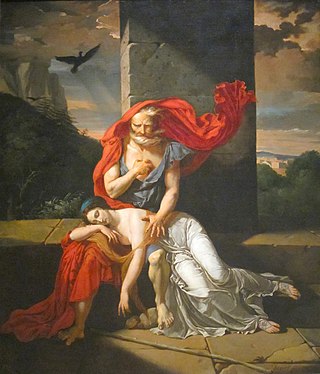
Fulchran-Jean Harriet was a French academic painter.

Gli Orazi e i Curiazi is an opera in three acts composed by Domenico Cimarosa to a libretto by Antonio Simeone Sografi, based on Pierre Corneille's tragedy Horace.

Horace is a play by the French dramatist Pierre Corneille, drawing on Livy's account of the battle between the Horatii and the Curiatii. Written in reply to critics of his Le Cid, it was dedicated to cardinal Richelieu and proved the author's second major success on its premiere in March 1640. Its protagonist Horatius is more daring than Rodrigue in Le Cid, in that he sacrifices his best friend and kills his sister Camilla. It was the basis for the libretti for the operas Les Horaces and Gli Orazi e i Curiazi. It is considered one of Corneille's great tragedies.

Alba Longa was an ancient Latin city in Central Italy in the vicinity of Lake Albano in the Alban Hills. The ancient Romans believed it to be the founder and head of the Latin League, before it was destroyed by the Roman Kingdom around the middle of the 7th century BC and its inhabitants were forced to settle in Rome. In legend, Romulus and Remus, founders of Rome, had come from the royal dynasty of Alba Longa, which in Virgil's Aeneid had been the bloodline of Aeneas, a son of Venus.
The gens Curiatia was a distinguished family at Rome, with both patrician and plebeian branches. Members of this gens are mentioned in connection with the reign of Tullus Hostilius, the third King of Rome, during the seventh century BC. The first of the Curiatii to attain any significant office was Publius Curiatius Fistus, surnamed Trigeminus, who held the consulship in 453 BC. The gens continued to exist throughout the Republic, and perhaps into imperial times, but seldom did its members achieve any prominence.

The gens Horatia was a patrician family at ancient Rome. In legend, the gens dates back to the time of Tullus Hostilius, the third King of Rome. One of its members, Marcus Horatius Pulvillus, was consul suffectus in 509 BC, the first year of the Republic, and again in 507. The most famous of the Horatii was his nephew, Publius Horatius Cocles, who held the Sublician bridge against the army of Lars Porsena circa 508 BC.

Duel of Champions is a 1961 film about the Roman legend of the Horatii, triplet brothers from Rome who fought a duel against the Curiatii, triplet brothers from Alba Longa in order to determine the outcome of a war between their two nations.

The overthrow of the Roman monarchy was an event in ancient Rome that took place between the 6th and 5th centuries BC where a political revolution replaced the then-existing Roman monarchy under Lucius Tarquinius Superbus with a republic. The details of the event were largely forgotten by the Romans a few centuries later; later Roman historians invented a narrative of the events, traditionally dated to c. 509 BC, but this narrative is largely believed to be fictitious by modern scholars.

Psyche Abandoned is a c. 1795 painting by Jacques-Louis David, now in a private collection. It shows Psyche as a crouching female nude in profile against a blue sky with a hill in the background. She stares at the viewer with an expression of loss, pain, and betrayal. Thought to have been painted during David's imprisonment during the French Revolution, it dates from either 1794 or 1795. Vertical in format, it diverges from the academic conventions for representing the female nude.
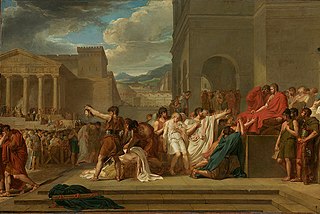
Brutus Condemning His Sons to Death is a 1788 painting by the Guadeloupe born French Neoclassical painter Guillaume Guillon-Lethière (1760–1832). It depicts the legendary founder of the Roman Republic Lucius Junius Brutus who overthrew Lucius Tarquinius Superbus the last King of Rome, watching the execution of his sons Tiberius Junius Brutus and Titus Junius Brutus stoically after having sentenced them to die for plotting to restore the Tarquin monarchy.
